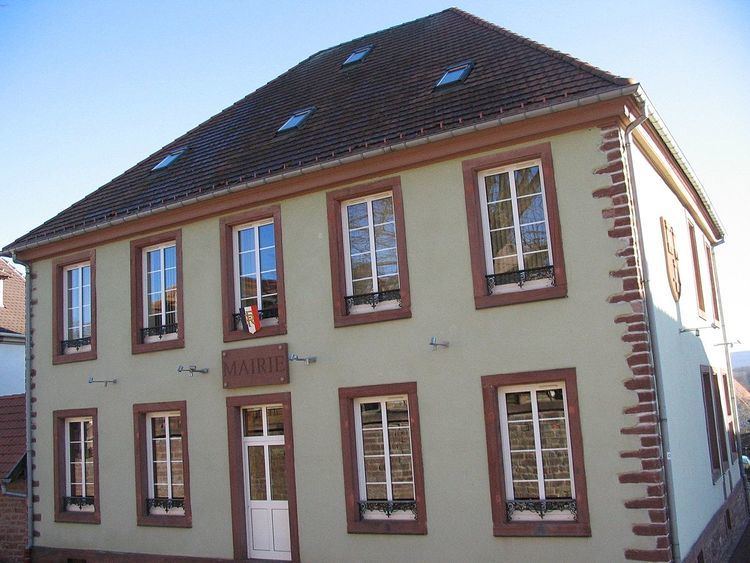Department Bas-Rhin Time zone CET (UTC+1) Area 5.96 km² Population 453 (1999) | INSEE/Postal code 67004 / 67310 Local time Sunday 11:27 AM | |
 | ||
Weather 9°C, Wind SW at 13 km/h, 62% Humidity | ||
Bois d allenwiller
Allenwiller (Alsatian: Allanwiller, French: Allunwillier) is a former commune in the Bas-Rhin department in the Grand Est region of northeastern France. On 1 January 2016, it was merged into the new commune Sommerau.
Contents
- Bois d allenwiller
- Map of 67310 Allenwiller France
- Dragon allenwiller mov
- Geography
- Distances
- History
- Administration
- Demography
- Repopulation after the Thirty Years War
- Education
- Economy
- Civil heritage
- Religious heritage
- Events and celebrations in Allenwiller
- References
Map of 67310 Allenwiller, France
The inhabitants of the commune are known as Allenwillerois or Allenwilleroises.
Dragon allenwiller mov
Geography
A small village in the Bas-Rhin department in the Alsace region, Allenwiller is part of the Canton of Saverne. It is located at an altitude of 242 metres and neighbours the communes of Salenthal and Singrist. The commune has an area of 596 hectares.
Allenwiller is located about 35 kilometres west by north-west of Strasbourg and 10 km south of Saverne. The nearest store and railway station are at Marmoutier about 7 kilometres to the north.
Distances
All distances are road distances measured from road D817 (Rue de Romanswiller). From Allenwiller to:
The largest town near Allenwiller is the town of Saverne, located northwest of the commune.
Two rivers pass through Allenwiller: the Sommerau and the Sommergraben.
History
Allenwiller has often changed ownership. First owned by the Abbey of Marmoutier, it passed to the Bishop of Metz in 828, then to the lords of Ochsenstein in 1187, to the County of Zweibrücken-Bitsch in 1485, to Hanau-Lichtenberg in 1570, then finally to Hesse-Darmstadt in 1736.
Successive names of Allenwiller were:
The first written record of the existence of Allenwiller traces back to the 10th century.
The origin of the coat of arms was from Ochsenstein Castle near Reinhardsmunster, via the forest house of Haberacker. This fortress had three interconnected castles.
The village often served as a pledge in return for a loan or debt.
In 1641 there were more people living in Allenwiller but the Thirty Years' War, poverty, famine, and pestilence destroyed the village. The repopulation of the village was carried out by families from Switzerland, Tyrol, Vorarlberg, and Normandy.
Administration
List of Successive Mayors
(Not all data is known)
Demography
In 2009 the commune had 507 inhabitants. The evolution of the number of inhabitants is known through the population censuses conducted in the commune since 1793. From the 21st century, a census of communes with fewer than 10,000 inhabitants is held every five years, unlike larger towns that have a sample survey every year.
Sources : Ldh/EHESS/Cassini until 1962, INSEE database from 1968 (population without double counting and municipal population from 2006)
At the 2011 census, there were 767 inhabitants in Allenwiller.
In 1793 the population of Allenwiller was very high, possibly due to the quartering of troops.
A slight increase:
First there was a decrease and then a rise in the second half of the century:
Repopulation after the Thirty Years War
Kieffer, in his Pfarrbuch of Hanau-Lichtenberg, published a survey dating from 1641. This is the statement of the royalties due to the lord. It lists all the different posts and after each post, there is the word "Nichts" meaning nil. It ends with the line "Wagenfrohnden nichts" meaning nothing. The explanation lies in a footnote: "es ist keine lebendige Seele mehr in Allenwiller" (there is no longer a living soul in Allenwiller).
In order to repopulate the village families came from Switzerland: the Clauss family, the Mullers, and the Zimmermanns came from the Bernese Oberland; the Gass family and The Steiners came from Basel. These people left their countries because the economic situation there was unenviable and a peasant revolt had been severely repressed. Other families came from Tyrol and Vorarlberg.
Still others came from Normandy. The Lord of Birkenwald, Gabriel du Terrier, brought families from his native province of Normandy. Their names underwent some modifications to French:
In 1687 Pierre Vitta was the manager of Birkenwald Castle.
Education
Students from Allenwiller attend nursery school in the commune. The primary school is at Salenthal. College students go to the Leonardo da Vinci College at Marmoutier and high school students go to the Leclerc school or to Haut-Barr in Saverne. In late 2011 a new school was built as an inter-school for the three villages that are in the regional grouping (RPI) (Allenwiller, Salenthal, and Birkenwald).
Economy
There was a sawmill in the village but it was sold. The nearest grocery store is at Romanswiller. A hypermarket is at Marmoutier. The courts are at Saverne and Strasbourg.
An Alsatian theatre takes place from February to May, but not every year for various reasons.
Civil heritage
The commune has a number of buildings and structures that are registered as historical monuments:
Religious heritage
The commune has several religious buildings and sites that are registered as historical monuments:
